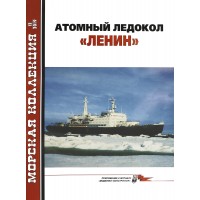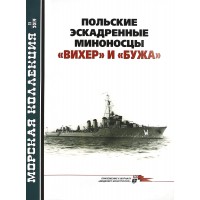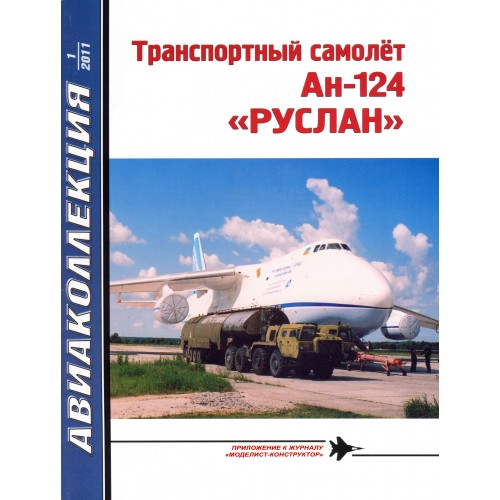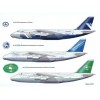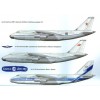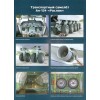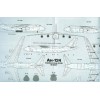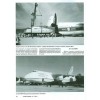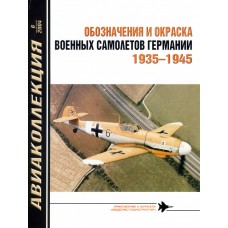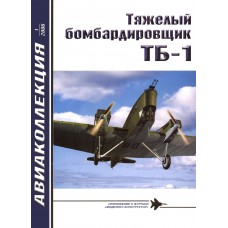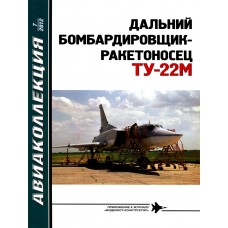AKL-201101 AviaCollection / AviaKollektsia 01/2011: Antonov An-124 Ruslan Strategic Airlift Jet Aircraft (NATO Reporting Name: Condor) . Photos, schemes, colour pictures. 32 pages, soft cover, text in Russian.
CREATING A PLANE
The creation of the An-22 military transport aircraft was, of course, a huge achievement of the aviation industry of the Soviet Union. The machine with NK-12 turboprop engines demonstrated the extreme capabilities of the 1950s technology. and became a step towards new, more cargo-carrying aircraft. The innovations of the An-22 consisted, first of all, in the technological processes mastered by the serial plant associated with the manufacture of large-sized panels and airframe units.
The appearance of the An-22 in 1965 stimulated the United States, which did not want to give up its leadership in aircraft construction, to create a heavier aircraft C-5A Galaxy (Galaxy). In turn, the American supergiant has prompted a response. So, in the decree of the Soviet government No. 564-180 of July 21, 1966 "On the main directions of development of aviation technology and weapons for 1966 - 70." the task of increasing the carrying capacity of domestic military transport aircraft to 100 - 120 tons was formulated. Development of the future Ruslan began two months after the signing of the relevant orders of the Ministry of Aviation Industry. A.Ya. Belolipetskiy - chief designer of the OKB Oleg Konstantinovich Antonov.
In the early 1970s. Kievites offered the customer projects of three heavy aircraft: "122", "124" and "126". At first, they wanted to solve the problem with "little blood".
In the project of the aircraft "122" (An-122) with a payload capacity of 80 tons, the An-22 fuselage was used, but with a swept wing, T-shaped tail and four double-circuit turbojet engines with a thrust of 25 tons each. But he was almost immediately dismissed as unpromising. The last project, "126th", with a lifting capacity of 140 tons, was a six-engine giant with a cargo compartment 37.5 m long, 6.4 m wide, 4.4 m high and with a high horizontal tail tail.
At the beginning of 1972, the military, taking into account TsAGI's warning about the excessive risk of creating such an aircraft, opted for the 124, the future Ruslan, which provided transportation of almost the entire range of domestic military equipment.
The first government decree on the creation of the An-124 (product "200") was signed on February 2, 1972, and a year later the customer could contemplate the layout of the future giant.
However, the "200" product had no particular advantages over the American S-5A, and the entire project had to be revised. An important role in this was played by P.V. Balabuev, at that time the first deputy general designer. His arguments were so convincing that in 1976 O.K. Antonov decided to completely revise the project. It should be noted that in the spring of the same year the technical design of the reusable space system "Buran" was presented to the customer for consideration, in which it was supposed to deliver the orbital vehicle to the cosmodrome using the ZM-T and An-124 aircraft.
The latter, apparently, was one of the first modifications of the Ruslan.
New requirements for the aircraft, designated "400", were approved by government decree No. 79-23 in January 1977. It took almost five years to rework the first version of the An-124. During the design, more than 500 possible aircraft layouts were analyzed, and about 200 models were investigated in wind tunnels. To lighten the glider and reduce aerodynamic drag, pressed wing panels up to 28 m long and large-sized fuselage panels were made, new structural materials, including composite ones, were used. All this, combined with the supercritical wing profiles, made it possible to improve the cruising aerodynamic quality of the plane by 20%, and the payload weight return by almost 15%. The thicker wing made it possible to increase the internal volumes and, accordingly, the fuel supply.
It was possible to reduce the specific fuel consumption of engines, to increase the accuracy of navigation equipment and the complexity of the maintenance of the machine (in comparison with the An-22 - several times). The use of a fly-by-wire control system (EDSU) made it possible to significantly reduce the reserves of longitudinal stability and lighten the plane by 3.7 tons. We abandoned the weight balancing of the rudders and ailerons, as well as anti-flutter weights, transferring the function of suppressing the EDSU oscillations. This saved another 3 tons.
The placement of the horizontal tail not on the keel, as was done on the American C-141, C-5A and the domestic Il-76, but on the fuselage also contributed to the reduction in the weight of the glider.
Perhaps the only hereditary feature of the new air "truck" is the chassis with independent suspension of supports and individual mechanisms for its cleaning.
The task for the development of a turbofan engine (TVLD) with a takeoff thrust of over 20 tf was given to Zaporozhye engine builders. There was no experience in creating an engine of such a thrust with a high bypass ratio in the country, so initially the American TF-39 installed on the C-5A was taken as a basis. But these were military engines with a low resource, while we needed a TVLD that could be installed on civil aircraft, which means that with a sufficiently high resource that reduced machine downtime. Then the engine builders turned their eyes to the English Rolls-Royce RB.211-22 engine and wanted to buy a dozen of them for later copying. But the British, apparently, have learned well the lesson of 50 years ago, associated with the sale of the turbojet engines "Nin" and "Derwent" to the Soviet Union, and agreed to sell only a large batch,
Then the Ukrainian engine builders decided to go their own way, and they were rescued by the D-36, recently created for the Yak-42 passenger airliner. As the stories of V.A. Lotarev, D-36 served as a prototype for the future D-18T.
Compared to its predecessor, the bypass ratio of 5.6 and the specific fuel consumption of 0.34 kg / kgf per hour remained the same, but the pressure increase in the compressor increased from 20 to 26 and the temperature of the gases in front of the turbine. Flight tests and refinement of the D-18T were carried out at the LII on the IL-76 flying laboratory in parallel with the tests of the Ruslan. Despite the extensive testing and development program of the engine, one of its main drawbacks - low gas-dynamic stability, which sometimes led to surge - remained for a long time. A similar case received worldwide publicity in September 1988 during the work of the next aerospace show in Farnborough. On the opening day of the exhibition during the takeoff run, when the speed reached 120 km / h, the crew stopped takeoff due to the shaking of one of the engines. It was necessary to urgently deliver a new TVLD from Kiev and only after its replacement to continue flights. I must say that surging phenomena in engines were not uncommon. Another such case took place during state tests, when the Ruslan was in the North Pole region.
AKL-201101 AviaKollektsia N1 2011: Antonov An-124 Ruslan Strategic Airlift Jet Aircraft (NATO Reporting Name: Condor) magazine
- Brand: AviaCollection / AviaKollektsia
- Product Code: AKL-201101 In Stock
-
$3.90
Available Options
Look at these products too:
AKL-200601 AviaKollektsia N1 2006: Tupolev TB-1 Soviet pre-WW2 heavy bomber magazine
AKL-200601 AviaKollektsia N1 2006: Tupolev TB-1 Soviet pre-WW2 heavy bomber. Photos, schemes, colour..
$3.90




